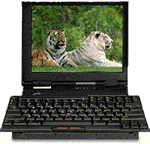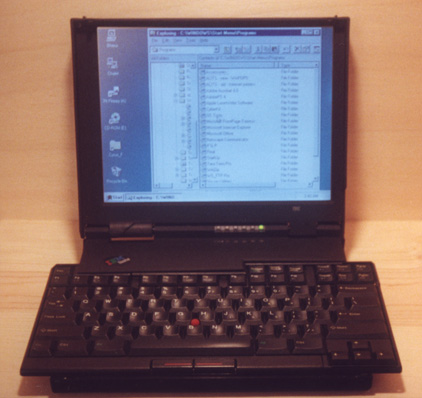

Here is some info that I found useful when I owned one of the coolest notebook computers ever made - IBM's "Butterfly" - the ThinkPad 701 series laptop computer.
What makes this notebook computer so cool is its stunning fold-out keyboard. The notebook measures only 9.7 inches wide when the it's closed. But as the lid is lifted up, a magic trick occurs! This computer has a full-sized, 11.5-inch wide, 85-key keyboard that unfolds and slides into place as the computer is opened for use!
The folding-keyboard mechanism is amazingly sturdy. Byte magazine wrote a delighted review of the keyboard when the computer first hit the market. Years later, many 701's are still chugging along with keyboards intact, a testimony to some terrific engineering by the folks at IBM.
When unfolded for action, this wonder machine has not only a full-sized keyboard, but also a nice 640 x 480 x 16-bit 10.4-inch screen. (The big difference between the two models of 701 is the screen: The 701cs has a dual-scan screen that offers a 20:1 contrast ratio, while the 701c boasts a fine TFT active-matrix screen with a 100:1 contrast ratio.) In the middle of the keyboard sits a TrackWrite "eraserhead" joystick pointer. All of this folds down into a cute super-portable package measuring just 9.7 x 7.9 x 1.7 inches x 4.5 pounds.
Of course, this 1996-era laptop is no longer a cutting-edge computing system. It tops out at 40 MB of RAM and 75 MHz of processor speed, so Windows 95 is the OS of choice. Windows 98 is painfully slow on this processor . . . . (For the adventurous tinkerer, 133-MHz replacement boards are available on eBay.) The one or two-hour battery life can also be a drag. And although the 10.4-inch screen will do for bare-bones word-processing and web surfing, it's certainly small by today's standards.
Nonetheless, the 701 series continues to have many fans - people who keep it around as a second computer, ready to be picked up on days when portability counts. At this writing (December 2000), the 701 is very actively bought and sold on eBay, where one can also find a steady supply of replacement batteries and other components.
Basic specifications from IBM.
specs1.html
Detailed specs from IBM.
specs2.pdf
Byte Magazine's review, including a multi-exposure photo of the
expanding keyboard and snapshots showing the various computer ports.
byte.html
IBM Success Story: the history of the 701 series.
IBMSuccessStory.html
Exploded view: how the parts fit together
d3kb6a4x.html
Part numbers for IBM's original-issue disk-drive (360, 540, and 720
kB)
diskDriveOptions.html
Larger hard drives. IBM only issued these computers with hard drives up to 720 MB. It is possible to replace your original hard drive with a nice, large hard drive. I had no trouble installing a 2.1 GB hard drive in my own 701c. (I've also heard of people installing 4 and 6 GB drives.) Here are some things to know if you choose to install a large (> 720 MB) drive.
Disk-Drive Requirements. You need a 2.5-inch IDE drive. The height should not be more than 12.5 mm. For example, one model that worked great for me was a 2.1 GB IBM Travelstar, model DTNA-22110 (part number 73H7670 / FRU part number 73H6427).
The "hibernate-file" issue. The two basic formats for your
hard drive are FAT16 and FAT32. FAT32 is generally better for large
drives. However, the 701 can only write its "hibernate" file to the hard
disk if at least one portion of the hard disk has the FAT16 format.
Therefore, if your entire disk is formatted as FAT32, then the hibernate
facility will not be available.
THE FIX: make sure at
least one partition on you hard drive is formatted in the FAT16 format.
A 43 MB partition formatted as FAT16 will be enough to store all the
contents of your RAM, even if you have the maximum amount of RAM (40
MB). (Sorry if this explanation sounds like mumbo-jumbo - it's just an
outline of the approach. I don't have the time or space to write a full
tutorial.) There are two approaches to making the FAT16 partition that you need. One
involves using a tool such as PartitionMagic. The other uses the FDISK
utility in DOS.
(If this is your first time formatting and/or
partitioning your drive, get someone to help you! Formatting and
partitioning are fairly complicated procedures that involve wiping all
the information from your computer's hard drive.)
In the following letter, a newsgroup poster suggested formatting
the entire disk as FAT32, and then using a tool such as Partition
Magic from Power Quest to
create the FAT16 partition.
hibernate.txt
Another way to do this, which worked for me, is to use the FDISK
utility in DOS to partition the hard drive appropriately. To do this,
you will need to boot up from a floppy, and then run the DOS utility
FDISK with the "/FPRMT" option. This option lets you choose which
partitions have which formats. The following page has more info on
FDISK and /FPRMT.
fdiskSecrets.html
The confused BIOS. In addition to the hibernate-file issue
mentioned above, there is a second issue that arises when you put large
hard drives in your 701. This issue seems to be totally cosmetic. After
you install your nice new hard drive, you will notice that the BIOS will
mis-report the drive size during start up. Instead of 2.1 GB, for
example, my computer always reported the hard-disk size as 150 MB. This
happens because the 701's 1996 BIOS does not expect a hard drive to be
bigger than 1000 kB. It truncates the number when it reports the size of
the hard disk. Thus, my 2150 MB hard drive was reported as 150 MB. This
seems to be no trouble. Windows 95 recognized the drive just fine, and I
never had any difficulty with the hard drive. The following note has a
short comment on this issue.
hibernate.txt
The expansion slot takes memory modules with the following characteristics.
Some compatible part numbers are listed here.
memOptions1.txt
IBM memory part numbers
memOptions2.html
Steve Carter's page.
http://www2.gol.com/users/hticn/thinkpad701c.html
Craig Leres's page (with nice info on
displays,
processors, and other 701 stuff).
http://www-nrg.ee.lbl.gov/leres/butterfly/
Klaus H. Fuchs' page.
http://www.verfasser.de/web/web.nsf/web/Thinkpad?OpenDocument&ExpandSection=5,2,7.2#_Section5
Linux on a ThinkPad 701? Sure! See Robert G. Mende Jr.'s page.
http://reality.sgi.com/mende/linuxTP701/
